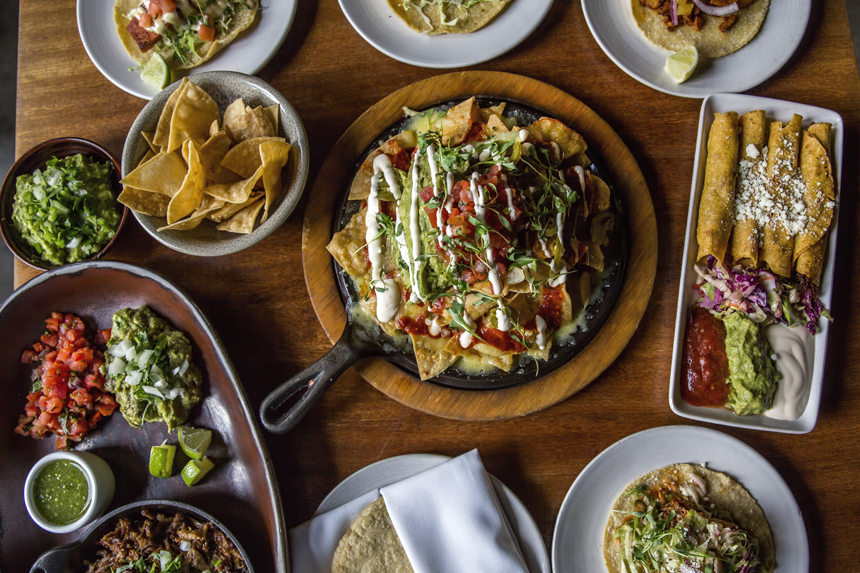Senior managing editor and logophile Andy Hollandbeck reveals the sometimes surprising roots of common English words and phrases. Remember: Etymology tells us where a word comes from, but not what it means today.
The community surrounding the offices of The Saturday Evening Post is host to a plenitude of wonderful Mexican restaurants (not to mention the Cuban place, the dim sum restaurant serving traditional Chinese cuisine that I’m afraid to eat, several noteworthy Middle Eastern eateries, and an Arby’s). That means quite often I find myself poring over a lunch menu packed with dishes bearing Mexican Spanish names.
You’ll find many of the same dishes at practically every Mexican restaurant, and while they are each identical in concept, every establishment has its own little delicious and unique way of preparing them.
But have you ever wondered about what the names of all those dishes really mean, or where they came from? Like any other words in any other language, they all have a history, and this week, I’m breaking down that history for some of the most common dishes you’ll find at your favorite Mexican restaurant.
Tortilla
The base for many of the dishes you’ll find on a Mexican menu, the tortilla gets its name from the Late Latin torta “round loaf of bread.” In Spanish, torta became a broad name for a cake or pastry. In American Spanish (which comprises all the various Spanish dialects in North and South America), the diminutive suffix -illa was added to describe the flat tortilla — literally “little cake” — that we know today.
If you’ve ever had a tart or a torte, these etymological relatives of tortilla also come from the Latin torta. (But not the tort of tort law.)
Burrito
The name for a flour tortilla wrapped around a filling traces its name to the Late Latin burricus “a small horse.” In Spanish, the word became burrico or borrico and was specifically used to describe a donkey. Burro is an irregular form of that word that is used especially in American Spanish. Like tortilla, burro was appended with a diminutive suffix; thus burrito literally means “little donkey.”
Exactly why this dish was named after a pack animal is up for debate. Some believe that because burritos are stuffed with a number of different things, they reminded people of the stuffed packs that a donkey might carry. Others believe burritos simply reminded people of donkeys’ ears.
The burrito isn’t as old as you might think: It wasn’t mentioned in Mexico until the end of the 19th century, and it didn’t become well-known in America (outside of California and Texas, anyway) until the 1930s.
Chalupa
A chalupa is a fried corn tortilla, with added fillings, that is shaped approximately like a boat, which is how it gets its name. In Spanish, a chalupa is a type of single-mast boat, the word probably coming from the French chaloupe for the same thing. (It’s likely related to the English sloop as well.)
Chile Relleno
Chiles rellenos are stuffed peppers. Obviously chile is the Spanish word for “pepper” (see “Enchilada” for more on that). Rellenos traces back to the Latin verb llenar “to fill” plus the re- “again, anew” suffix. Rellenar, then, means “to stuff, to refill”; thus chile relleno = “stuffed pepper.”
The Latin llenar is interesting here: It comes from lleno meaning “full,” which in turn comes from the Latin plenus (source of the word plenty), also meaning “full.” Add the re- prefix, and you uncover the ancestor of replenish, which is cognate with relleno.
Chimichanga
The deep-fried burrito is believed to have been developed in areas along the U.S.-Mexican border during the 1960s. A number of restaurants in Tucson, Arizona, have laid claim to the invention of this treat, and they usually involve someone accidentally dropping a burrito into a vat of hot oil.
The word chimichanga is said to be a combination of a word meaning “seared or singed” and a rude expression. As one of the stories goes, the person who accidentally dropped the burrito into the oil caught themselves halfway through cursing aloud and then changed course and said a word which in Mexican Spanish means “trinket, thingamajig.”
Enchilada
You might have an ah-ha! moment when you realize that the en- and –ada in enchilada are affixes. The central root of the word is chile (which comes not from Latin, but from the Aztec language Nahuatl). The en- prefix means “in,” so the Mexican Spanish verb enchilar means “to put chile in it, to season with chile.” It’s from the past participle of this verb that we get the noun enchilada for a (usually corn) tortilla wrapped around a savory filling, baked, and served with chile sauce.
Fajitas
The fajitas has been on restaurant menus in the United States only for about 50 years. The word comes from the Latin fascia “band” (of the binding type, like a belt, not the musical type), which became the Spanish faja “belt, sash.” This led, in Mexican Spanish, to fajita “little belt, little strip.”
If you’ve ever had fajitas in which the meat was so tough it was like chewing through a leather strap, I’m sure it was an unpleasant experience, though perhaps a more etymologically accurate one. The fajitas (usually used in plural, and you’ll see why in a minute) as a dish got its name because it is served with marinated strips of meat — as opposed to being ground, pulled, or chopped.
Nachos
I wrote a bit about the legend of nachos in 2020’s “9 Things You Didn’t Know Were Named after People.” According to that story, which may or may not be true, Nacho was the nickname of Ignacio Anaya Garcia, a restaurateur in Piedras Negras in the 1940s who was running out of food but not customers and put together this dish with what he had on hand.
Quesadilla
The Spanish word queso (as well as the English word cheese) traces back to the Latin word for the same product: caseus. From queso came the Spanish quesada, a type of cheesecake (and, oddly, the insect genus to which cicadas belong). Quesadilla, with its diminutive -illa suffix, is literally a “little cheescake.”
Taco, Taquito
In Mexican Spanish, the word taco literally means “plug, wadding.” If you can imagine someone incessantly whining about being hungry, being given a bit of food, and told, “Use this plug to stop up your cake-hole,” you can imagine how taco came to mean “light lunch” instead.
A taquito is a “small taco,” though it is rolled around the filling and usually fried as well.
Become a Saturday Evening Post member and enjoy unlimited access. Subscribe now




Comments
The origins of these Mexican food items seem to make sense overall etymology speaking than many other words, most recently ‘mischief’, right?! A restaurant that serves really good fajitas is a keeper, especially served on a sizzling skillet. It gives you control over how you make it. Designed to be designed by you!
I usually specify (on some of the others) that they’re mild spice-wise. Still, requesting extra sour cream is never a bad idea just in case something needs to be toned down a bit more.
We have a lot of Thai and Chinese restaurants out here in addition to Mexican. Middle Eastern (Persian) and Indian less so, but they’re good overall. I can’t find a French or Polynesian restaurant out here to save my life. There used to be a wonderful one (Chez Nous) in Toluca Lake that’s been gone since 2012. The escargot in the hot butter-garlic sauce was incredible.
Thanks for the “9 Things” link from early 2020. A whole other time and place, way back in the rear view mirror. With the high cost of everything, dining out is a less frequent treat I’m afraid. Gas is down to the mid $5 range, which we have to be grateful for since it was nearing $7 several weeks ago. Coming up? I don’t want to know.
The weather this time of year is. About alleges and snezzing to pas it on the others people